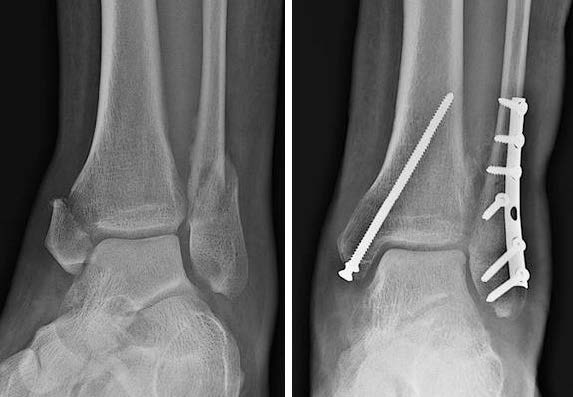The ankle is made up of three bones:
- the tibia (shin bone), which forms the inside, front, and back of the ankle
- the fibula, which forms the outside of the ankle
- the talus, a small bone that sits between the tibia and fibula and the heel bone
The ends of these bones are called malleoli. The tibia has a medial (inside) malleoli and a posterior malleoli. The fibula forms the lateral (outside) malleoli.
A broken ankle (ankle fracture) occurs when the malleoli are broken. These fractures are very common. Ankle fractures happen with twisting of the ankle, falls, car accidents, or other injury. One, two, or all three malleoli can be broken. Ankle fractures can be displaced (out of place) or non-displaced. Symptoms of an ankle fracture include pain especially with weight bearing, swelling, bruising, and problems with ankle motion. X-rays help determine if treatment from a foot and ankle orthopedic surgeon is needed.
Ankle Fracture Surgery
The main goal of ankle fracture surgery is to put the ankle joint back in place and to stabilize the bones to heal. Getting the ankle joint back in place helps to decrease the risk of developing arthritis of the ankle. Stabilizing the ankle with plates and screws may allow earlier motion.
Diagnosis
When the ankle fracture is unstable or in bad position, surgery is needed to repair the ankle. In some cases, the bones of the ankle may poke through the skin. These are called open ankle fractures and require surgery.
Ankle fracture surgery is not needed if the ankle is in position and stable despite the fracture. Surgery may be too risky when patients have a severe medical condition.
Treatment
Antibiotics are given shortly before the start of the surgery. Once the patient receives antibiotics and anesthesia, the surgery can safely begin. Incisions are made through the skin of the ankle where the bones are broken. The breaks in the bone are then repositioned and held in place with implants (screws and plates). After the ankle fracture is repaired, the patient’s leg is placed in either a protective splint, cast or boot. Some patients go home after surgery the same day while others may stay overnight in the hospital.
Specific Technique
Most ankle fracture surgery involves open reduction and internal fixation (ORIF). An incision is made over the ankle to see the fractured bones. Like a jigsaw puzzle, the pieces of the broken bones are placed back together (open reduction). The broken bones are then held together (internal fixation) in this correct position with metal plates and/or screws. This internal fixation provides stability so movement can begin shortly after surgery as the ankle fracture heals.

Left, a bimalleolar ankle fracture before surgery. Right, the ankle fracture after it has been fixed.
Recovery
Surgical treatment of ankle fractures allows patients to regain ankle function while the bones and joint heal. Immediately after surgery, your ankle will be immobilized for a few weeks. Once the wounds are healed, you will be fitted for either a cast or a boot. Many surgeons use a removable boot. The boot protects the ankle as it heals but can be removed to allow washing, wound checks, and icing.
Once the broken bones start to heal, you will be told when you can put weight on the ankle in your cast or boot. You are then allowed to wean out of the cast or boot. You can progress to normal activities once the bones are fully healed. Some patients may need physical therapy for their ankle to regain full movement and strength. While everyone is different, it may take up to a year after surgery for some patients to regain ankle function.
Risks and Complications
All surgeries come with possible complications, including the risks associated with anesthesia, infection, damage to nerves and blood vessels, and bleeding or blood clots. Potential long-term problems after ankle fracture surgery include ankle joint stiffness, weakness, and arthritis. Possible complications include infection and problems with healing. Factors that increase risks after ankle fracture surgery include diabetes, steroid use, and cigarette smoking.
FAQs
Will my ankle hardware (plate and/or screws) have to be removed at some point?
Plates and screws used to fix an ankle fracture are not removed if they are not causing problems. Most people do not have problems with the plate and screws. In rare cases, the plate and screws can cause some pain or irritation. When this happens, the hardware may be removed after the fracture is healed, about a year from the original surgery.

